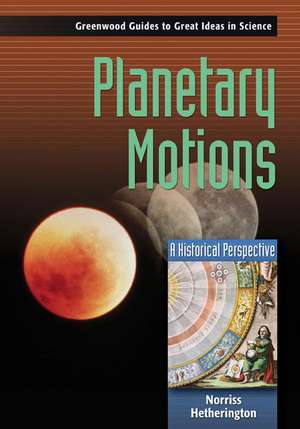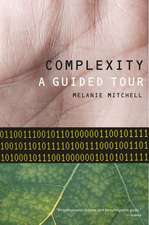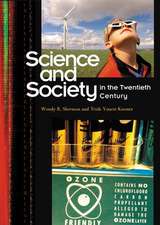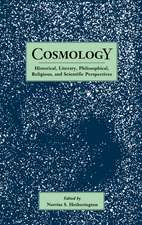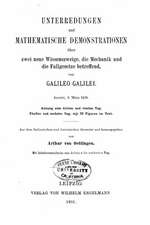Planetary Motions: A Historical Perspective: Greenwood Guides to Great Ideas in Science
Autor Norriss S. Hetheringtonen Limba Engleză Hardback – 29 iul 2006 – vârsta până la 17 ani
Preț: 306.62 lei
Preț vechi: 529.65 lei
-42% Nou
Puncte Express: 460
Preț estimativ în valută:
58.68€ • 63.72$ • 49.29£
58.68€ • 63.72$ • 49.29£
Carte tipărită la comandă
Livrare economică 22 aprilie-06 mai
Preluare comenzi: 021 569.72.76
Specificații
ISBN-13: 9780313332418
ISBN-10: 031333241X
Pagini: 248
Dimensiuni: 178 x 254 x 22 mm
Greutate: 0.69 kg
Editura: Bloomsbury Publishing
Colecția Greenwood
Seria Greenwood Guides to Great Ideas in Science
Locul publicării:New York, United States
ISBN-10: 031333241X
Pagini: 248
Dimensiuni: 178 x 254 x 22 mm
Greutate: 0.69 kg
Editura: Bloomsbury Publishing
Colecția Greenwood
Seria Greenwood Guides to Great Ideas in Science
Locul publicării:New York, United States
Notă biografică
Norriss S. Hetherington is the director of the Institute for the History of Astronomy and a Visiting Scholar with the Office of the History of Science and Technology at the University of California, Berkeley. He has written extensively on the history of astronomy and cosmology, and has edited Encyclopedia of Cosmology: Historical, Philosophical, and Scientific Foundations of Modern Cosmology, and Cosmology: Historical, Literary, Philosophical, Religious, and Scientific Perspectives.
Cuprins
ForewordIntroductionAn Introduction to the History of ScienceBabylonian Planetary AstronomyPlato and Saving the PhenomenaEudoxus and Concentric SpheresEccentrics and EpicyclesEquivalenceAstronomy and PhysicsSaving the Phenomena QuantitativelyPtolemy's Exposition of Mathematical SstronomyReality or Mathematical Fiction?The Greatest Astronomer of Antiquity or The Greatest Fraud in the History of Science?Islamic Planetary AstronomyRevival in the WestCopernicus and Planetary MotionsThe Copernican RevolutionBreaking the CircleIsaac Newton and ravityThe Newtonian RevolutiuonGlossaryTimelineBibliography
Recenzii
Hetherington covers the history of attempts to understand planetary motion, starting with the Babylonians, continuing through Plato and Ptolemy, and ending with Copernicus and Newton. He has written extensively on this subject and is the director of the Institute for the History of Astronomy at Berkeley. His expertise is evident in his clear, insightful overview of astronomy and the personalities of the people who pursued it, but what is unique is the ease with which he connects science to the cultures in which it was practiced. The index includes Bach, Julius Caesar, Dionysius, John Donne, Frederick II, Goethe, Alexander Hamilton, Thomas Jefferson, Mohammed, Moliere (Moliere) , Mozart, Voltaire, and even God. The writing is authoritative but also accessible and humorous: the conflict between Descartes' and Newton's understanding of gravity is summarized by the statement that In Paris everything was explained by a pressure that nobody understood; in London everything was explained by an attraction that nobody understood either. A thorough, engaging study. Highly recommended. General readers; lower- and upper-division undergraduates.
Focusing on classical planetary mechanics from the period from Plato through Newton, this book is a feast for those interested in the history of astronomy..Here..[i]s a clear and concise exposition of the thinking of some of the greatest minds in the history of science on the queen of all disciplines..Throughout the book are fascinating boxes and sidebars on social and humanistic issues related to the astronomy of the time, and the author has also included useful instrumental exercises by which the reader can delve into the subject further..[t]his is an exceptional text that will prove useful in introductory and intermediate-level history-of-science courses..[I] recommend the book highly to anyone who simply is curious about how we have come to know the structure of our solar system and the place of humankind in the universe.
Director of the Institute to the History of Astronomy, Hetherington begins by reviewing the history of science in general to provide a framework. Then he traces the evolution of modern ideas about how planets move from Babylonian planetary astronomy to the Newtonian revolution. Among the stages are Plato, eccentricities and epicycles, Ptolemy, Islamic planetary astronomy, and the Copernican revolution. No knowledge of astronomy is assumed.
Now and again a resource comes along that provides a new look at an old, even ancient, topic. In this book, teachers of higher-level, secondary physics classes, along with their students, can discover a new perspective on the historical development of theories involving planetary motion. The author approaches the physics concepts of gravity, laws of motion, forces, and fields, among others, through its explanation of how great scientists of the past actually developed them..This books helps us understand the history that has brought us to our current physics practice, understanding, and instruction. As a resource for teachers or required reading for students, this book can help to provide a unique foundation for future physics classes. Through a detailed timeline and bibliography that supports its contents with research, its approach to the presentation of the material will truly keep readers involved.
Focusing on classical planetary mechanics from the period from Plato through Newton, this book is a feast for those interested in the history of astronomy..Here..[i]s a clear and concise exposition of the thinking of some of the greatest minds in the history of science on the queen of all disciplines..Throughout the book are fascinating boxes and sidebars on social and humanistic issues related to the astronomy of the time, and the author has also included useful instrumental exercises by which the reader can delve into the subject further..[t]his is an exceptional text that will prove useful in introductory and intermediate-level history-of-science courses..[I] recommend the book highly to anyone who simply is curious about how we have come to know the structure of our solar system and the place of humankind in the universe.
Director of the Institute to the History of Astronomy, Hetherington begins by reviewing the history of science in general to provide a framework. Then he traces the evolution of modern ideas about how planets move from Babylonian planetary astronomy to the Newtonian revolution. Among the stages are Plato, eccentricities and epicycles, Ptolemy, Islamic planetary astronomy, and the Copernican revolution. No knowledge of astronomy is assumed.
Now and again a resource comes along that provides a new look at an old, even ancient, topic. In this book, teachers of higher-level, secondary physics classes, along with their students, can discover a new perspective on the historical development of theories involving planetary motion. The author approaches the physics concepts of gravity, laws of motion, forces, and fields, among others, through its explanation of how great scientists of the past actually developed them..This books helps us understand the history that has brought us to our current physics practice, understanding, and instruction. As a resource for teachers or required reading for students, this book can help to provide a unique foundation for future physics classes. Through a detailed timeline and bibliography that supports its contents with research, its approach to the presentation of the material will truly keep readers involved.
